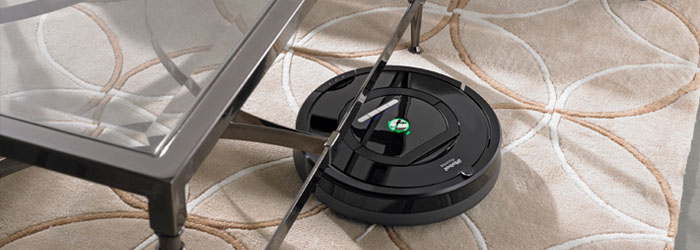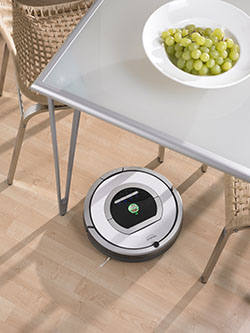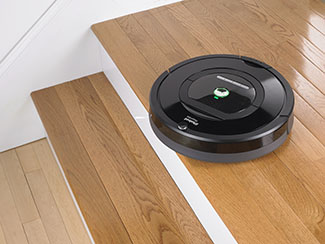Should You Buy Your Mom a Robot for Mother's Day?
 09 May 2017
09 May 2017 

Six Questions to Ask Before Buying a robot for Mother’s Day
A couple years ago, Neato Robotics of Newark, Calif., surveyed American mothers to ask them about vacuums as Mother’s Day gifts. Only 15 percent of mothers surveyed said they would be pleased with getting an upright vacuum as a gift, but 77 percent said they would be happy with a smart and powerful robot vacuum.
Maybe it’s not a fun, romantic or charming gift idea, but robot vacuums may be on the brink of becoming a trend in a big way. Probably because vacuuming the house is one of those jobs that cause a lot of family friction, and Mom -- and Dad -- are tired of getting stuck with the job.
 After all, when it comes to high tech smart equipment for your home, very little new stuff for sale can replace hard physical labor by humans. No big new things like washers, dryers and refrigerators with ice makers once were. A phone app that unlocks the door or lowers the temperature in a room can’t change your life. But maybe a robot that vacuums carpets or mops up tile floors can do that. Or could it?
After all, when it comes to high tech smart equipment for your home, very little new stuff for sale can replace hard physical labor by humans. No big new things like washers, dryers and refrigerators with ice makers once were. A phone app that unlocks the door or lowers the temperature in a room can’t change your life. But maybe a robot that vacuums carpets or mops up tile floors can do that. Or could it?
So, what do robot cleaning machines offer, what are the drawbacks, and what will they cost? Here are six things you need to know:
1 | What’s out there?
More than a dozen companies produce robot vacs, including iRobot of Massachusetts, founded by MIT experts, and other startups. There are also robot vacuums from big names in appliances, like Dyson, Bissell, Hoover, Samsung and Miele. Some companies put out new models with new features every year.
2 | What do reviews say?
You can find dozens of reviews, rankings and video tests online for various brands. iRobot claims to be global leader in home robot sales and has sold 15 million worldwide since 2002. It often ranks among the top three in reviews. Others that rank well are Samsung’s Powerbot, Neato, Infinuvo, ITouchless, Dyson and more.
3 | What’s the latest feature?
Some vacs are Wi-Fi enabled so that you can start them cleaning via a phone app. iRobot’s Roomba has just announced that homeowners can use Amazon Alexa to start the cleaning. Roomba’s 980 model also provides up to 10 times the air power over previous models.
4 | What are the basics?
Most are circular- or semi-circular-shaped machines, several inches tall, that automatically travel the house on wheels and pick up dirt with rotating brushes. As they clean, some can map your floors; they don’t just bump around. They’re great for vacuuming areas that are hard to reach with traditional uprights: like under tables, dressers and beds. But they can’t climb or go down stairs.
They have a built-in dustbin that needs frequent cleaning. It can fill up quickly at first, robot companies say, but that may be because homeowners are cleaning up under beds more regularly for the first time. Dust and debris should reduce over time.
They use a rechargeable battery pack. Generally, you press a button and the robot takes off. The battery, which may need annual replacement, can keep the vac going for an hour or two. Some companies say their vacuums automatically return to a charging station after cleaning is done.
5 | What kind of job do they do?
Many reviewers agree they have improved greatly over the years and have better suction and patterns for cleaning floors. Consumer Reports recently reported: “They’re still not ready to replace a full-sized upright or canister vacuum, but for daily cleaning of surface debris, a robotic vacuum can work wonders.”
A robot vacuum might work for light cleaning now and then, but can’t clean like suction from a regular-style vacuum. He has also seen homes where robot vacs have etched permanent circular patterns into carpeting.
These vacuums may be a great daily solution for picking up dust and debris from hard-surfaces like tile or hardwood. James Baussmann, public relations manager for iRobot, told us: “Many customers use a robotic vacuum in conjunction with a stick or traditional upright vacuum for cleaning jobs that are out of reach for a robot such as drapes, stairs and bigger cleanups.”
Our advice to homeowners: You still need to invest in a well-sealed HEPA filter vacuum, upright or canister, with a dust-holding container that is well-sealed. Then vacuum at least once a week and maybe more. Letting dirt particles build up in carpets is like rubbing sandpaper on the fibers.
6 | What do they cost?
Robot vacuums are not cheap. Depending on where and how you buy them, prices for newer, top-rated models can range from $700 to $1,000. But there are many other models priced at slightly under $400 or less.
If the idea of a robot vacuum seems great for your home, you might want to invest in one. But don’t buy something that will just gather dust in a closet because it’s too complicated to use.
Other Robot Machines of Interest
Robot Floor Mops – iRobot also makes a robot floor mop called the Bravaa ($199) which can do wet mopping and dry and damp sweeping and is good for hard-to-reach areas around toilets. Ecovacs and other companies make them, too. Some sell for less than $200.
Robot Lawn Mowers – There are lots of these mowers, including some from Dyson ($1,000); Polaris ($800 and $1,000) and Landroid ($850).
###
Photo Credits:
RELATED CONTENT:
- Blog: Get Ready to Phone Your Refrigerator
- DIY Q&A: What Is Home Automation?
- DIY Q&A: I Want to Automate My Home. Where Should I Start?
- DIY Q&A: What Are The Benefits of Home Automation?
- Podcast: Smart Appliances & Pest Control with Action Termite
Print this page
recent post
- Duck, Duck, Duct! How Often Should Ductwork Be Cleaned?
- Vinyl vs. Fiberglass Windows: Which Is The Better Choice Of Replacement Window?
- We May Be The Grand Canyon State, But The Rocky Mountains Are Important For Arizona
- Welcome to Arizona! Things A Newbie to Arizona Should Know
- The Pros & Cons of Buying A Flipped House
- Getting In On The Ground Floor
- Why It’s More Critical Than Ever To Get Your AC Serviced Before Summer
- The Reality of Remodeling
- What To Look For When Comparing Your Roofing Quotes
- What To Expect When Buying New Windows & Doors
